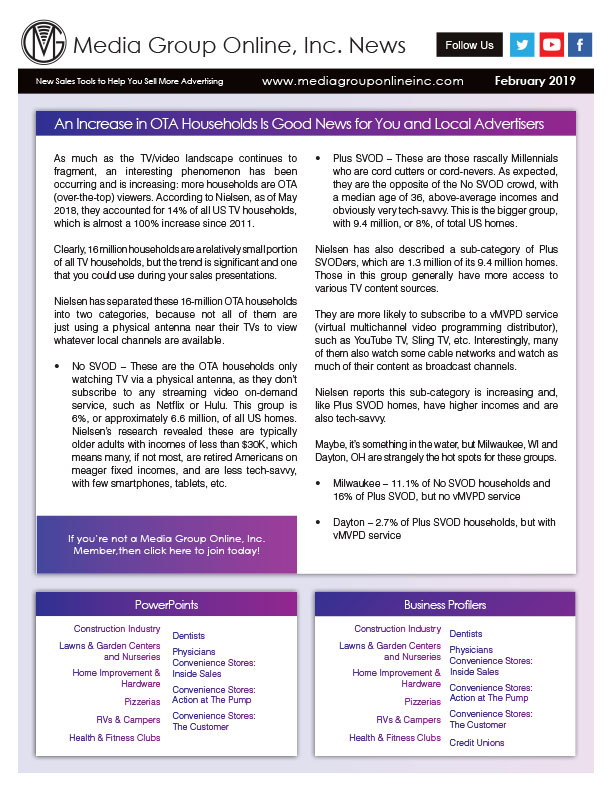An Increase in OTA Households Is Good News for You and Local Advertisers
As much as the TV/video landscape continues to fragment, an interesting phenomenon has been occurring and is increasing: more households are OTA (over-the-top) viewers. According to Nielsen, as of May 2018, they accounted for 14% of all US TV households, which is almost a 100% increase since 2011.
Clearly, 16 million households are a relatively small portion of all TV households, but the trend is significant and one that you could use during your sales presentations.
Nielsen has separated these 16-million OTA households into two categories, because not all of them are just using a physical antenna near their TVs to view whatever local channels are available.
- No SVOD – These are the OTA households only watching TV via a physical antenna, as they don’t subscribe to any streaming video on-demand service, such as Netflix or Hulu. This group is 6%, or approximately 6.6 million, of all US homes. Nielsen’s research revealed these are typically older adults with incomes of less than $30K, which means many, if not most, are retired Americans on meager fixed incomes, and are less tech-savvy, with few smartphones, tablets, etc.
- Plus SVOD – These are those rascally Millennials who are cord cutters or cord-nevers. As expected, they are the opposite of the No SVOD crowd, with a median age of 36, above-average incomes and obviously very tech-savvy. This is the bigger group, with 9.4 million, or 8%, of total US homes.
Nielsen has also described a sub-category of Plus SVODers, which are 1.3 million of its 9.4 million homes. Those in this group generally have more access to various TV content sources.
They are more likely to subscribe to a vMVPD service (virtual multichannel video programming distributor), such as YouTube TV, Sling TV, etc. Interestingly, many of them also watch some cable networks and watch as much of their content as broadcast channels.
Nielsen reports this sub-category is increasing and, like Plus SVOD homes, have higher incomes and are also tech-savvy.
Maybe, it’s something in the water, but Milwaukee, WI and Dayton, OH are strangely the hot spots for these groups.
- Milwaukee – 11.1% of No SVOD households and 16% of Plus SVOD, but no vMVPD service
- Dayton – 2.7% of Plus SVOD households, but with vMVPD service



